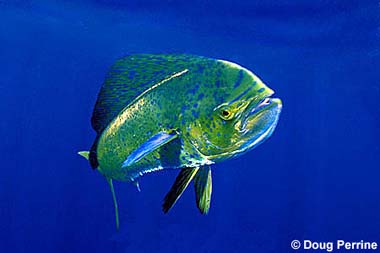
Coryphaena hippurus
The dolphinfish is also often called mahi-mahi, and not at all related to the marine mammal dolphins. This colorful, distinct fish has a long body and a blunt face, with a forked caudal fin (tail), and a dorsal fin that runs the length of its body. It is brightly colored, mostly golden-green and blue that fades to a yellow-white underside, and irregular patches of metallic blues and greens on its back and sides. They usually grow to 3 feet long but have been caught at almost 6 feet.
Order: Perciformes
Family: Coryphaenidae
Genus: Coryphaena
Species: hippurus
Common Names
The common English name for this fish causes much confusion. The fish known as the “dolphin” is not related to the marine mammal of the same common name (family Delphinidae). Additionally, two species of dolphinfish exist, the common dolphinfish (Coryphaena hippurus) and the pompano dolphin (Coryphaena equiselis). Both these species are commonly marketed by their Pacific name, mahi-mahi.
Common English language names include dolphinfish, dolphin, common dolphin, common dolphin fish, common dolphinfish, dolphin fish, green dolphin, mahi mahi, and mahi-mahi.
Other common names are ailai (Tamil), anfalous (Arabic), avlis (Tamil), badahlen (Tamil), bakhti bakhti (Arabic), belitong (Malay), cabishot (Papiamento), chapeau gouverneur (French), clic (French), corado (Spanish), corifena (Rumanian), coryphene commune (French), dakaunomoutas (Greek), dauphin (French), delfim (Portuguese), delfinka (Slovene), dhiya vannava (Sinhalese), doirado (Portuguese), doirado-de-topete (Portuguese), doirado macho (Portuguese), dolfiini (Finnish), dolfijn (Dutch), dolfijnvis (Dutch), dorad (French), dorade (Afrikaans), dorade coryphene (French), dorado (Spanish), dorado delfin (Spanish), dourada (Portuguese), dourade (Spanish), dourado (Portuguese), dourado comum (Portuguese), drader (Papiamento), dradu (Papiamento), ersuuch (Paluan), fei niau fu (Mandarin Chinese), fulusi (Swahili), galvannava (Sinhalese), goldmakrele (German), golok (Malay), goudmakreel (Dutch), guldmakrel (Danish), guldmakrill (Swedish), gullmakrell (Norwegian), ikan lumadang (Malay), ikan lumba (Malay), ili koni (Gela), kadapangan (Makassarese), kal vanna (Tamil), koko (Marshallese), koppurai-kula (Tamil), korifene (Albanian), koryfena (Polish), lambouqa (Arabic), lambuka (Arabic), lampuga (Italian), lampuka (Maltese), lemadang (Malay), llampuga (Spanish), lobo (Portuguese), mahi mahi lapa (Hawaiian), mahi mahi oma (Hawaiian), mahihi (Hawaiian), man-sae-gi (Korean), masimasi (Samoan), mladang (Javanese), msi’a amerikano (Arabic), ngau tau yue (Cantonese), pandje (Komoro), parang (Malay), raaman (Hebrew), rad hava (Sinhalese), radheva (Sinhalese), sapatorra (Portuguese), scubaan (Somali), shiira (Japanese), te masimasi (Tuvaluan), te takua (Kiribati), tepoar (Carolinian), ti klik (Creole), tolofine (Niuean), toohyaku (Japanese), vanna (Tamil), and vannava (Sinhalese).
Importance to Humans
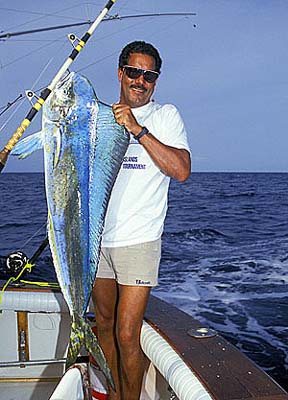
This fish is highly prized both as a gamefish and commercially. It can also be raised through aquaculture methods. Fishers take advantage of the dolphinfish’s attraction to floating objects, setting up floating bunches of bamboo reeds or planks to concentrate dolphinfish prior to setting nets. The flesh is marketed fresh and frozen and is highly valued.
Danger to Humans
There have been reports of ciguatera poisoning from human consumption of this fish. Ciguatera poisoning is caused by the bioaccumulation of ciguatoxins in the flesh of tropical marine fishes. Ciguatoxins are produced by marine dinoflagellates that grow attached to marine algae and as such may be incidentally ingested by herbivorous fishes. Large piscivorous reef dwelling fishes occupying the apex of the food chain become reservoirs for the highest amounts of ciguatoxin by feeding on other members of the reef community. Poisoned people report gastrointestinal maladies that may last several days, a general weakness in their arms and legs, and a reversal in the ability to differentiate hot versus cold. The illness is serious and symptoms may persist for weeks.
Conservation
Studies conducted on dolphinfish populations have concluded that it should be able to withstand high levels of harvest. Life history characteristics, including fast growth rates, high reproductive capability, and low age at maturity, make the dolphinfish resistant to overfishing within the Gulf of Mexico and south Atlantic fishery. However, further information is needed for the entire range of dolphinfish before an overall assessment of the status of this fish can be completed.
> Check the status of the common dolphinfish at the IUCN website.
The IUCN is a global union of states, governmental agencies, and non-governmental organizations in a partnership that assesses the conservation status of species.
Geographical Distribution
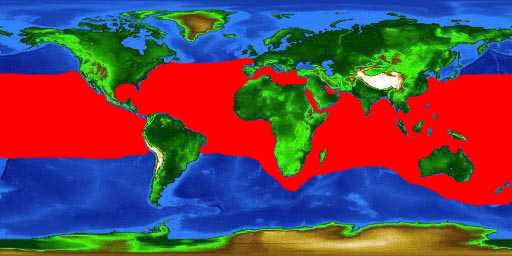
The dolphinfish is distributed in tropical and subtropical waters throughout the Atlantic, Indian, and Pacific Oceans. It is abundant in the Gulf of Mexico, the Florida Current, and throughout the Caribbean. In the eastern Atlantic Ocean, dolphinfish are found between the Bay of Biscay (France) and the mouth of the Congo and as far south as the southern tip of Africa. Populations in the eastern Pacific Ocean range from the coast of Oregon and California south to the Galapagos Islands and Peru. Dolphinfish are found between latitudes 46°N and 38°S in the western Pacific Ocean, reported around the Philippine Islands, Sea of Japan, Taiwan, and the Sea of Okhotsk. It also occurs in the northern and central Indian Ocean and throughout the Mediterranean Sea.
Habitat
Generally a pelagic fish, the dolphinfish is found offshore under floating objects. It is sometimes known to follow large ships and to hangout under large floating mats of sargassum. Dolphinfish are also found near the coast, ranging in depth from 0-279 feet (0-85 m). Small dolphinfish travel together in schools ranging from just a few fish to over 50 individuals. The larger adult fish travel alone or in pairs.
Biology
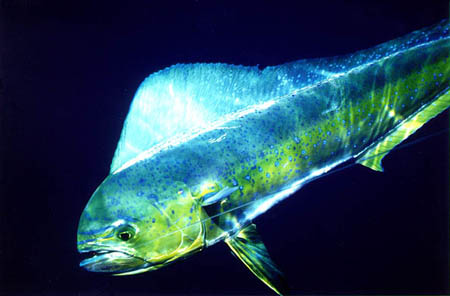
Distinctive Features
The two species of dolphinfish are easily distinguishable. Both exhibit the same elongate, fusiform body shape. The single dorsal fin extends the length of the body. The anal fin begins approximately in the middle of the body and ends at the same point as the dorsal fin. The pelvic fins are located under the pectoral fins and can be compressed into a shallow groove on the body. The caudal fin is strongly forked. The head is blunt and the mouth contains many small teeth as well as a small and oval-shaped tooth patch on the tongue. Cycloid scales cover the body. Displaying sexual dimorphic growth, mature males develop a prominent bony ridge at the front of the head. The dolphinfish can be distinguished from the pompano dolphin (Coryphaena equiselis) by its body depth. Body depth of the dolphinfish is less than 25% of its standard length, while the pompano dolphin body depth is greater than 25%. The anal fin is concave and pectoral fins half the length of the head.
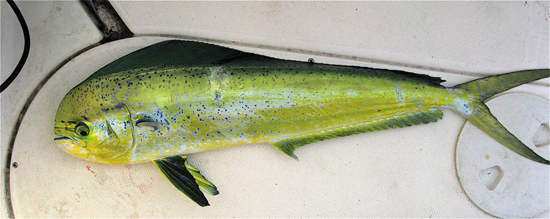
Coloration
Coloration of dolphinfish is quite dramatic with golden hues on the sides, irregular blotches of metallic blue and greens on the back and sides, and white and yellow on the underside. This fish is very colorful underwater, catching light and reflecting a wide range of brilliant colors. Freshly caught individuals change coloration very quickly, fading to a uniform silvery color. Small individuals and juveniles have well-defined alternating light and dark vertical bars on the sides of body that continue onto the dorsal and anal fins. Juvenile dolphinfish have white-tipped caudal fins and black pelvic fins while juvenile pompano dolphinfish have white-edged caudal fins and no pigment on the pelvic fins.
Dentition
A small and oval tooth patch covers half the tongue of the dolphinfish. This is distinguishable from the pompano dolphinfish that has a large square tooth patch covering most of the width of the tongue. The mouth is large, containing many fine teeth arranged in bands.
Size, Age, and Growth
The dolphinfish is a large fish, known to reach a maximum of 6 feet (2 m) in length, but more commonly to lengths of 3 feet (1 m). This fish commonly weighs 30 pounds (14 kg) with a maximum of more than 65 pounds (30 kg). The record for Florida waters is 77 pounds, 12 ounces (35.2 kg) and the world record is 87 pounds (39.5 kg). Dolphinfish that school together range in size from 1-20 pounds (.5-9 kg) while larger individuals live alone or in pairs. Sexual maturity is reached in 4-5 months (3 months for captive fish) and spawning first occurs at lengths of approximately 8 inches (20 cm). Dolphinfish grow rapidly throughout their life, with a maximum life span of 4 years.
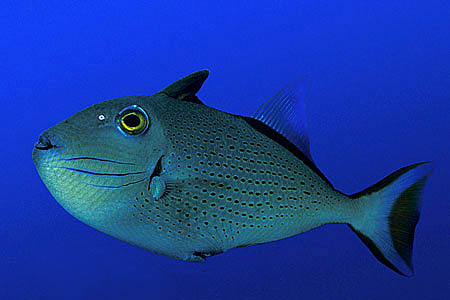
Food Habits
Dolphinfish are generalists with prey varying according to season and size of the individual. They feed during the day on small oceanic fishes (flyingfish, man-o-war fish, sargassum fish and triggerfish), juveniles of large pelagic fish (tunas, billfishes, jacks, mackerels, and dolphinfish), pelagic larvae of benthic fish (flying gunards, triggerfish, pufferfish, and grunts), and invertebrates (cephalopods, crabs, and schyphozoans).
Many observations have been made on the feeding habits of dolphinfish. Dolphinfish are swift-moving, agile predators and are able to overcome most prey items. This fish often associates with Sargassum in the Florida Current and Gulf Stream, where they prey primarily upon the smaller fishes and invertebrates associated with these tide lines. They are not selective in their feeding habits, although diet changes with growth. Larvae and juveniles feed primarily upon crustaceans, especially copepods. Adults feed mostly upon bony fishes, with flying fish (Exocoetidae) constituting approximately 25% of the food by weight. Sargassum is frequently found in the stomachs, but this is probably an incidental intake associated with foraging in the sargassum communities. Dolphinfish feed primarily during the day, as they rely upon the vision (as well as their lateral line system) to detect prey. There is evidence that they may also feed at night when the moon provides ample light. Males are apparently more active feeders than females, evidenced by the larger amounts of food found in their stomachs. Males tend to be larger than females of the same age, and thus probably need more energy to support their metabolism. Dolphinfish often hunt in pairs or small packs.
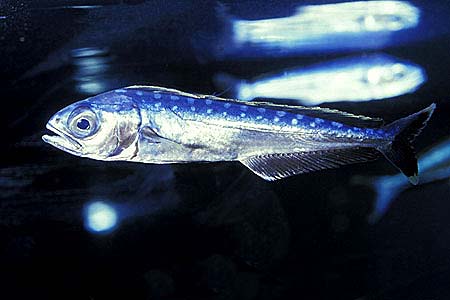
Reproduction
The spawning season for dolphinfish is long, and multiple spawnings per year are common in both males and females. Dolphinfish spawn in pairs, rather than communally, with spawning occurring year-round in the tropics. Young dolphinfish have been found year round in the Florida Current, supporting this assumption. In the northern and southern extremes of the range, they apparently spawn only in the warmer months. Larvae are found in tropical waters worldwide. Young dolphins are found in the Florida Current year round, but peak abundance occurs in the summer. Larvae hatch at approximately 4 mm total length, and reach a length of 5.7 mm within four days. At 15 days, the larvae are approximately 15 mm long. Vague adult characteristics are visible at this size, and the eyes and mouth are fully developed. Juvenile dolphins are marked with a pattern of alternating dark and light bars at 10-20 mm in length. As the juveniles grow, these bars become more obscure, and are non-existent in many individuals.
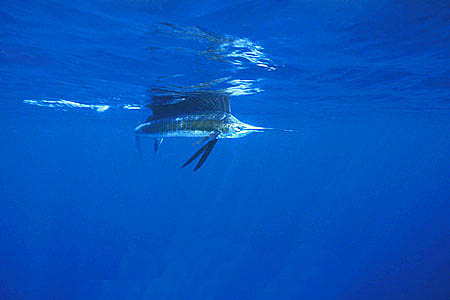
Predators
In the Atlantic Ocean, albacore tuna (Thunnus alalunga), yellowfin tuna (Thunnus albacares), and blue marlin (Makaira nigricans) are predators of the dolphinfish. Dolphinfish are commonly observed with holes pierced through them by marlin bills. Blue marlin, black marlin (Makaira indica), yellowfin tuna and sailfish (Istiophorus platypterus) are common predators of the dolphinfish in the western Pacific Ocean. Other predators of the dolphinfish include swordfish (Xiphias gladius), sharks, and porpoises as well as seabirds.Parasites
A dolphinfish caught off the coast of North Carolina contained three internal parasites: the isopod Livoneca ovalis, the nematode Contracaecum sp., and an unidentified acanthocephalan. A copepod, Lernacenicus longiventris, was also found attached to dorsal fins of numerous individuals. Several hundred Dinurus tornatus, a helminth, were collected from the stomach of one dolphinfish with lesser numbers from other specimens. Other observations concluded that dolphinfish are commonly infested with protozoans, acanthocephalans, nematodes (roundworms), and cestodes (tapeworms) as well as copepods and isopods.
Taxonomy
Carl Linnaeus (1758) originally described the dolphinfish as Coryphaena hippurus. Synonyms include Scomber pelagicus Linnaeus 1758, Coryphaena fasciolata Pallas 1770, Coryphaena chrysurus Lacepède 1801, Lepimphis hippuroides Rafinesque 1810, Coryphaena imperialis Rafinesque 1810, Coryphaena immaculata Agassiz 1829,Coryphaena argyrurus Valenciennes 1833, Coryphaena dolfyn Valenciennes 1833, Coryphaena dorado Valenciennes 1833, Coryphaena marcgravii Valenciennes 1833, Coryphaena scomberoides Valenciennes 1833, Lampugus siculusValenciennes 1833, Coryphaena suerii Valenciennes 1833, Coryphaena virgata Valenciennes 1833, Coryphaena vlamingii Valenciennes 1833, Coryphaena nortoniana Lowe 1839, Coryphaena japonica Temminck & Schlegel 1845, and Ecterias brunneus Jordan and Thompson 1914.